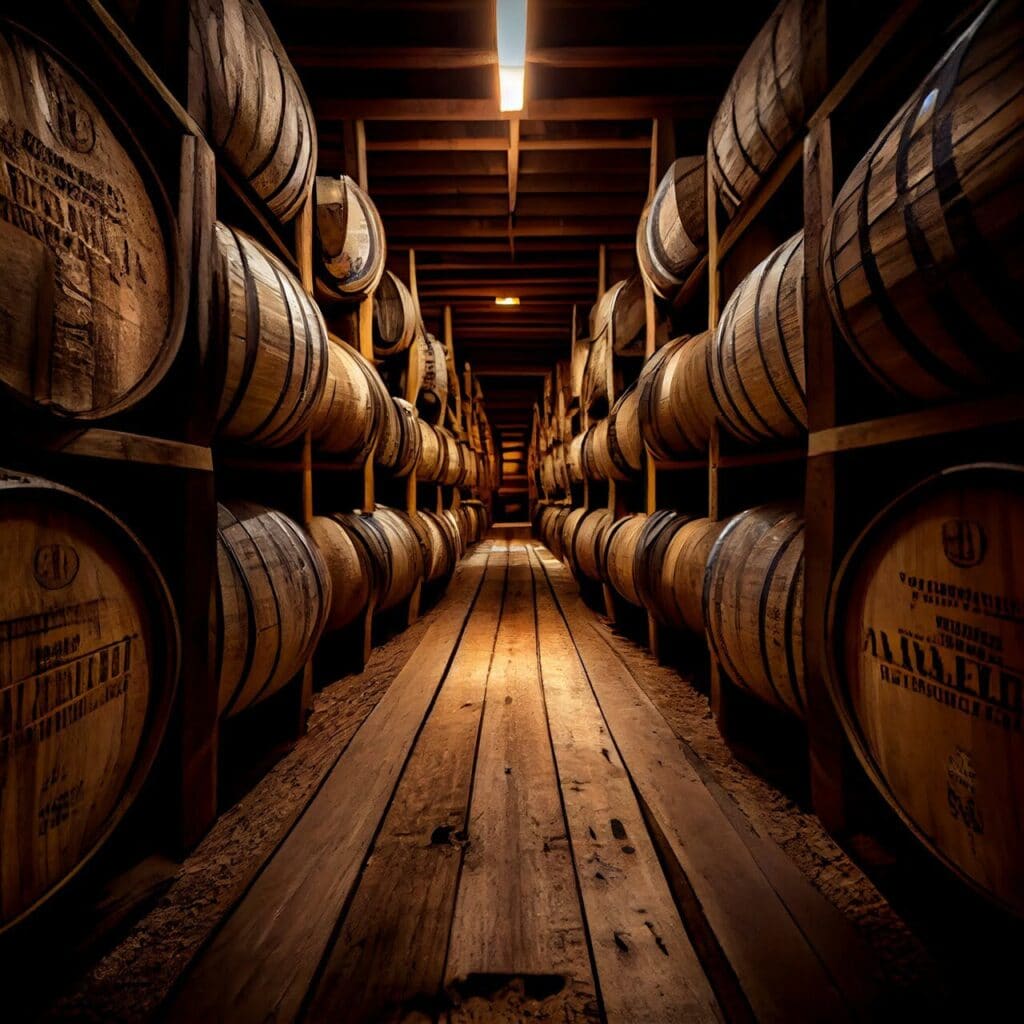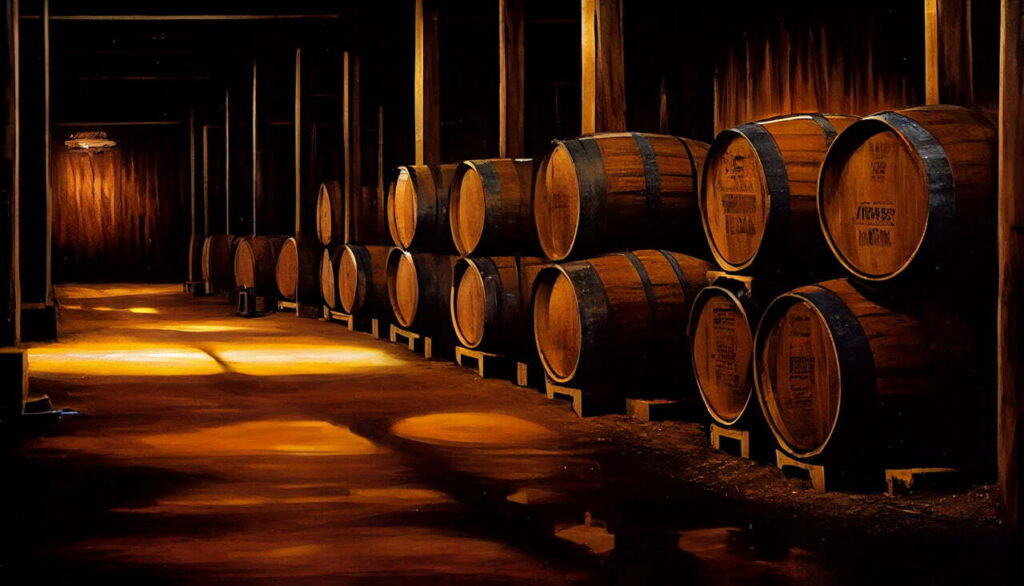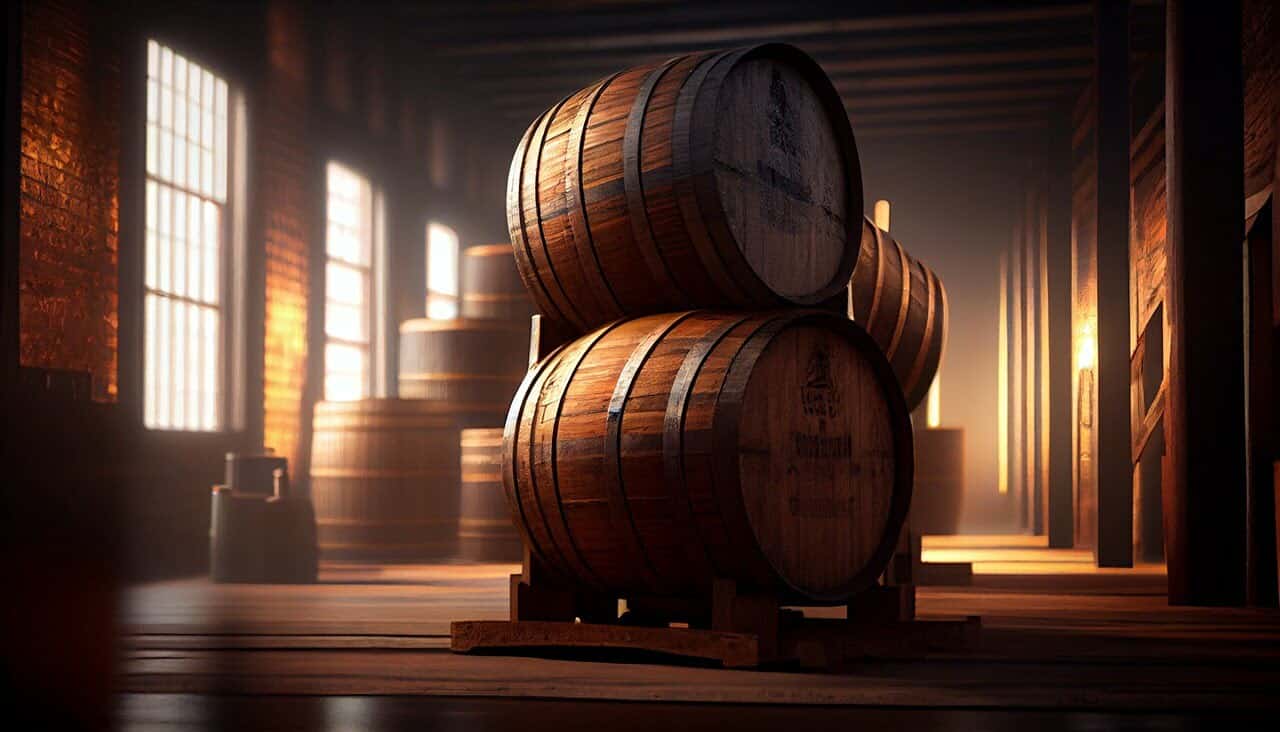It’s no secret that there’s an intense appreciation for barrel proof bourbons, as these crafted liquors help whiskey-lovers appreciate the subtle differences in flavor between bourbons from different geographical regions and distilleries. But what exactly is barrel proof bourbon, and what is the proof of bourbon straight from the barrel? In this article, I’ll answer these questions and more.
Come with me as I take a deep dive into the world of barrel proof bourbon.
Table of Contents
Definition of barrel proof bourbon
Barrel proof bourbon is a whiskey that has been stored in barrels and which maintains the strength it had when it was placed in the barrel. This means that “Proof” (an indication of alcohol content), is determined by testing samples directly from the barrel and not after it has been brought into a bottle. This proof is often much higher than what you’ll find from typical commercial bottle proof as it is left undiluted from the barrel.

The Proof stated on whiskey bottles such as traditional bourbons or rye whiskeys, for example, refer to products that have been bottled after diluting with water to a specific level. Barrel proof bourbon does not undergo this process and instead, where noted on their respective bottles, will reflect their original proof when they were tested directly from the barrel.
By leaving bourbon at its original proof level and not diluting any further during bottling, most barrel-proof whiskeys also deliver greater intensity in taste when compared to lower proofs; more oak tannins are emphasized due to the relatively higher alcohol content preventing these compounds from breaking down too quickly. Ultimately, this provides a more flavorful experience for those who enjoy high-proof spirits.
Barrel Proofbourbon may be referred to in differing ways depending on region or intended use; cask strength, overproof or navy strength are alternative terms referring to a liquid at amounting to over 100°Proof (50% Alcohol by volume). Barrel Proofbourbon generally has an ABV of between 49% – 58%. The highest ABV Bourbon currently available comes at 134°Proof (67% Alcohol by Volume) however; many producers offer high-proof Bourbons between uncut 110º through129ºProof , demonstrating what can be achieved when straight from the barrel without further dilution.
History of barrel proof bourbon
The history of barrel proof bourbon is as unique and varied as the bourbon makers themselves. In the 1800s, bourbon was made in much the same way it is today – corn-based mash, aged in charred oak barrels, and bottled at 40- to 50-proof. As time went on, distillers sought new ways to differentiate their products. The concept of barrel proof bourbons came into play in 1838 when an enterprising Kentucky distiller produced a 120-proof moonshine. This unique liquor soon became popular with those who wanted an undiluted form of Kentucky whiskey that was straight from the barrel itself.
In the early 1900s, distilleries began bottling higher proof bourbons for discerning drinkers who desired something even more distinct than regular common whiskey. To meet this trend, many began to label their spirits as “Barrel Proof Bourbons” – unadulterated straight from the barrel at whatever strength it had been before being placed into bottles. It became so popular that by 1915 more than half of all bottle holders were labeled with some degree of Barrel Proof Bourbon on them.
Today’s popularity of Barrel Proof Bourbons continues to surge due to its unaltered flavor profile, which allows aficionados and connoisseurs alike to experience a range of complexity that cannot be found in traditional bourbon whiskeys or other spirits. On average, most Barrel Proof Bourbons are between 125 – 130 proof but can reach up to 140 – 150 proof (or above 70% alcohol by volume). Examples include Elijah Craig 24 Year Single Barrel Barrel Strength Bourbon Whiskey and Four Roses Small Batch Single Barrel Limited Edition High Strength Bourbon Whiskey.
What is the Proof of Bourbon Straight from the Barrel?
Do you know what the proof of bourbon straight from the barrel is? Many people are familiar with the concept of barrel proof bourbon, but they may not know exactly how it is made or what the proof is.
In this article, we will discuss the concept of barrel proof bourbon and explain the proof of bourbon straight from the barrel. We will also look at what proof is barrel strength bourbon and what proof is bourbon in the barrel. Finally, we will discuss some of the highest proof barrel strength bourbons available today.
Factors that affect the proof of bourbon in the barrel
The proof of bourbon straight from the barrel is a topic of much debate. There are several factors that can determine what proof a bourbon is in the barrel including the distillery location, how long it was aged and how much aging has occurred.
In general, most bourbons are aged for anywhere between four to five years in new charred white oak barrels. During this time, evaporation and absorption occurs both inside and outside the barrel causing changes to the flavor profile of the whiskey as well as its proof level. The longer a whiskey is stored in its barrel, the more evaporation and absorption that occurs around it resulting in there being less liquid whiskey left when it reaches your glass.
Additionally, distilleries located at higher elevations tend to experience higher levels of natural evaporation due to pressure changes caused by changing climatic conditions. Conversely, low elevation distilleries often see lower evaporation levels due to these same pressure changes. This means that barrels filled at a lower elevation may be bottled with higher proofs than those filled at a higher elevation as more liquid is left after aging.
Finally, some bourbon makers will bottle their whiskeys at different proofs depending on how they wish to market their product or match certain flavor profiles they are targeting—this can vary significantly from store shelf-to-shelf and even bottle-to-bottle! Liquor stores will often label these “barrel strength” or “cask strength” bourbons indicating that no additional water has been added during bottling—only what was naturally evaporated out of the barrel during aging remains inside each bottle. Knowing this information can help give you an idea as to what proof you might find your favorite brand of bourbon at!
The highest barrel proof bourbon
The highest barrel proof bourbon is determined when the bourbon is bottled straight from the barrel without adjustment for dilution or filtration. It generally falls around 120 proof (60% ABV) as this is usually the upper limit of alcohol content that can be achieved before further distillation is required. This type of bourbon should be served slightly diluted with a splash of water to enhance its flavors and aromas. It’s important to note that since these bourbons are never adjusted for dilution, their proof can vary significantly – even within one batch.
In contrast, many commercial bourbons have already been diluted and filtered, resulting in a standard drinking strength of 80 to 100 proof (40-50% ABV). Even at this relatively lower level of alcohol concentration, it still carries a significant level impact on the palate if consumed neat or on the rocks.
How to Drink Barrel Proof Bourbon
Barrel Proof Bourbon is a type of whiskey that has been distilled straight from the barrel and bottled without being diluted or modified. It is usually bottled at a much higher proof, usually between 110 and 144, a significantly higher proof than non-barrel proof Bourbons.
If you’re looking to experience the rich, complex flavors of Barrel Proof Bourbon, then you’ve come to the right place – this article will discuss drinking Barrel Proof Bourbon the right way.
Choosing the right glassware
When it comes to enjoying barrel proof bourbon, the glass you use is just as important as simply opening a bottle. The right type of glassware will not only enhance the flavor of your drink, but it will also help trap aromas that can give you an even more detailed experience.
The best glasseware for barrel proof bourbons starts with a tulip-shaped glass. This style of glass curves inward like a regular rocks glass and prevents significant amounts of evaporation, thereby maintaining optimal flavors, aromas, and the heat associated with barrel strength bourbon. As an added bonus, tulip glasses make it easier to swirl and swirl your bourbon — which releases more spectrum of both flavor characteristic beneath spirit’s surface so you can appreciate every sip.
Picking out a snifter or nosing glass is also great when tasting or drinking high-proof liquor. It has a wide base that quickly narrows at the top; allowing your hand to warm up the liquid on contact! The aromatics released from the spirit comes in handy for those who want to sniff out flavors such as oak, caramelized sugars, dried fruit and spices which are made more intense by its original high alcohol content!
No matter what type of glass you decide to go with – just remember don’t forget: always use an appropriate sized pour for any alcohol being consumed…practice moderation and drink responsibly!
Adding water to reduce the proof
Drinking barrel proof bourbon is a special experience, but it can be intimidating for those not used to its strength. Fortunately, there are ways to ease into the full-bodied flavor of this spirit. One method is adding a bit of water to reduce the proof and bolster flavor notes.
Be sure to use filtered or mineral water, as tap water may add unwanted elements such as chlorine that can dramatically alter the taste of your bourbon. Use just enough water to bring the proof down – roughly two parts bourbon to one part water should do the trick. But don’t overdo it! Once the proof has been cut too much, it’s impossible to get back and you won’t be able to enjoy the unique complexities of these bourbons anymore.
This method works well for bourbons that start out around cask strength (or higher), as they will be significantly easier on your palette after adding a bit of water. If your chosen expression is already lower than cask strength yet still too strong for you, then perhaps sticking with smaller amounts is the better option – simply take a tiny sip at first, then adjust from there depending on your preference. Always remember: there is no right or wrong when choosing how much (or little) water to add – adjust accordingly until you find that perfect balance for yourself!
Drinking barrel proof bourbon neat
When it comes to drinking barrel proof bourbon, the best way is to savor it neat. Savoring means you take a small sip so you can just enjoy the aroma and taste without overwhelming it with risk of over-proof. Neat is how most experts agree barrel proof should be enjoyed, as it will provide you with the full flavor and experience that makes this spirit so unique.
For starters, make sure to begin by having a taste of water before you sample your bourbon neat. This water can be used as a palate cleanser between sips of bourbon in order to enhance your appreciation while keeping alcohol risks at bay. When served neat, this type of bourbon has concentrated flavors such as sweetness from the corn, spicy notes from the rye and nutty tastes from barley which are able to develop on the palate in balance with the high proof content.
The best way to understand barrel proof Bourbon is by simply tasting it for yourself. Color seldom tells anything about flavor or quality; when it comes down to tasting barrel strength whiskey – whether straight from a bottle or straight from a barrel — knowing where each one falls on the scale between softness and astringency will give you an idea of its character as well as its complexity. By taking your time and simply savoring each sip before taking another, you’re sure to get an understanding on what each pour has contributed when hoping to enjoy some quality time with a glassful of Barrel Proof Whiskey!
Conclusion
In conclusion, barrel proof bourbon is a unique spirit that has its own flavor character, production process, and proof levels. The strength of the spirit can vary greatly depending on the amount of time it is aged and the proof it is bottled at.

Understanding the different elements of barrel proof bourbon can help you choose the right one for your preferences and needs.
Benefits of drinking barrel proof bourbon
Drinking barrel proof bourbon has many advantages, and it’s important to understand the benefits before making a purchase. Barrel proof bourbon is stronger than your average bourbon, contains more aroma and flavor compounds, and will age differently than an already bottled bourbon.
The higher proof gives more flavor notes in the liquid with each sip. As the alcohol content increases when the spirit is taken from the barrel, more complex molecules interact in interesting ways that you may not find in a whiskey that has been cut with water to bring it down to a lower proof than comes straight from the barrel. This results in stronger flavors being imparted even over time as you drink it—so with each sip you get more flavor. This means that instead of drinking your whiskey just for taste or aesthetics, you are enjoying a glass of history filled with powerful taste notes exploding on your tongue!
Additionally, since barrel proof bourbons contain higher amounts of alcohol, they can age differently due to their increased alcohol content. Aged at cask strength can create a deeper level of aging than would be typically expected if it was intense-flavored bourbons were taken out of an oak barrel at 80 proof or lower. On average, you can expect approximately four years per additional degree of alcohol present when aging bottle proofs up to 100-proof while aging at true cask strengths longer can extend flavors even further.
The importance of barrel proof bourbon in the bourbon-making process
When it comes to making bourbon, the importance of barrel proof spirits cannot be overstated. The proof of the spirit that goes into the barrel determines how much flavor and color are extracted from the charred oak in the barrel, as well as how much alcohol is added to the spirit. Because of this, distillers carefully select the proof that best suits their product.
Barrel proof bourbons are typically between 100 and 125-proof (50-62% ABV) – higher than many other liquors. This allows for more flavor extraction from the wood during aging, as well as a final product with more complexity and depth on the palate. It also helps to preserve some of the character that may have been lost during distillation (which can strip away some complexity).
Due to its high proof, barrel proof bourbon can often be more expensive than traditional bourbons because it requires greater effort in production and a longer maturation period. For example, cask strength or barrel strength bourbons may take years before they’re ready for bottling. The extra time allows for even more flavor extraction from the wood when compared to standard bourbons which generally don’t age for very long before being bottled and sold.
In short, by investing in high-proof or cask strength or barrel strength bourbons you’re investing in a superior product with potent characteristics that cannot be achieved through just bottling regular spirits straight from a still. It requires scientifically precise techniques applied by skilled craftspeople who understand not just how different proofs work together but how each individually affects flavor profiles—all working together in harmony make a bottle of high-quality spirit worthy of your hard-earned cash!
Frequently Asked Questions
What is barrel proof bourbon?
Barrel proof bourbon is a type of bourbon whiskey that is bottled straight from the barrel without any added water or dilution. It is typically bottled at higher alcohol levels than regular bourbon, ranging from 120 to 140 proof.
What is the proof of bourbon straight from the barrel?
The proof of bourbon straight from the barrel typically ranges from 120 to 140 proof.
What is the highest barrel proof bourbon?
The highest barrel proof bourbon available is Pappy Van Winkle 23 Year, bottled at a whopping 137.2 proof.


